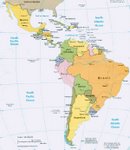Working In Latin America: An Overview
 General
General
Teachers generally recommend searching for jobs in person, usually in late February for South America to catch the school year at the right time (and August for Mexico and Central America which follow a Northern Hemisphere schedule), though plenty of language schools hire all year round. An in-person search is good first of all so you can check out schools for yourself and not be reliant on an online post, and also because Latin American job posts just aren’t abundant online. One teacher on the Latin America Board at Dave’s ESL Cafe suggested that this is not always due to a true lack of jobs but rather a different way of looking at the internet: schools are simply used to recruiting people in person. It may also be that the only ones that need to turn to the internet are those that can’t do it in person (because they are shady, etc). All that said, another teacher at Dave’s pointed out that some schools are so off the beaten path that advertising online is the only way teachers will find out about them.
Now might be a good time to point out that Guy Courchesne, a blogger and teacher trainer for Teachers International, is a good Latin America resource who was a huge help in the preparation of this post. So, if you think anything is wrong, blame him, not me. (Just kidding! Joking aside I take full responsibility for any inaccuracies) Read on…
As far as requirements, experience and a BA degree are probably the most desired qualifications in Latin America, closely followed by a TEFL certificate. Aside from the International Job Boards at Dave’s ESL Café, a list of schools is maintained in the Latin American Section. There are separate forums for Argentina, Brazil, Chile, Costa Rica, Mexico, and Peru.
Salary
Wages do not tend to be high by North American standards, but vary even among Latin American countries themselves. $600 to $1000 per month is not uncommon for a new teacher, but expect the harder-to-get jobs at universities and swanky language schools to be the highest paying.
It depends on the city and cost of living and spending habits of the individual teacher – but it isn’t uncommon for the wages to allow a nice standard of living in that place. One teacher at Dave’s ESL Café pointed out that while the cost of living may vary greatly between, for example, Rio and other towns in Brazil, due to a number of factors, wages vary less – so sometimes it is possible to live comparatively better in a less expensive smaller town than a bigger one. He spoke specifically about Brazil, but it is worth it to take cost of living into account wherever you are. Help finding housing may be provided, but including housing in the salary is uncommon.
Regulations
Work permits can be hard to get – the teacher in Brazil mentioned above emphasized that they are hard enough to get that the typical “six months out of any one year on a tourist visa” may be the maximum that many teachers can stay. This Guy Is Teaching Abroad has a thorough write-up about work visas for Mexico. I’m going to bow out due to a genuine lack of knowledge about work permits, but one source indicates that Mexico may be the best bet for acquiring working papers, but even then, many people work under the table. Chile, Argentina, Brazil, and Costa Rica are notoriously difficult, but again, many work illegally. Risks run from fines to deportation, but visa/border runs to neighboring countries are common and there is little fear of repercussion; people come back for a new 90 or 60 day tourist visa.”